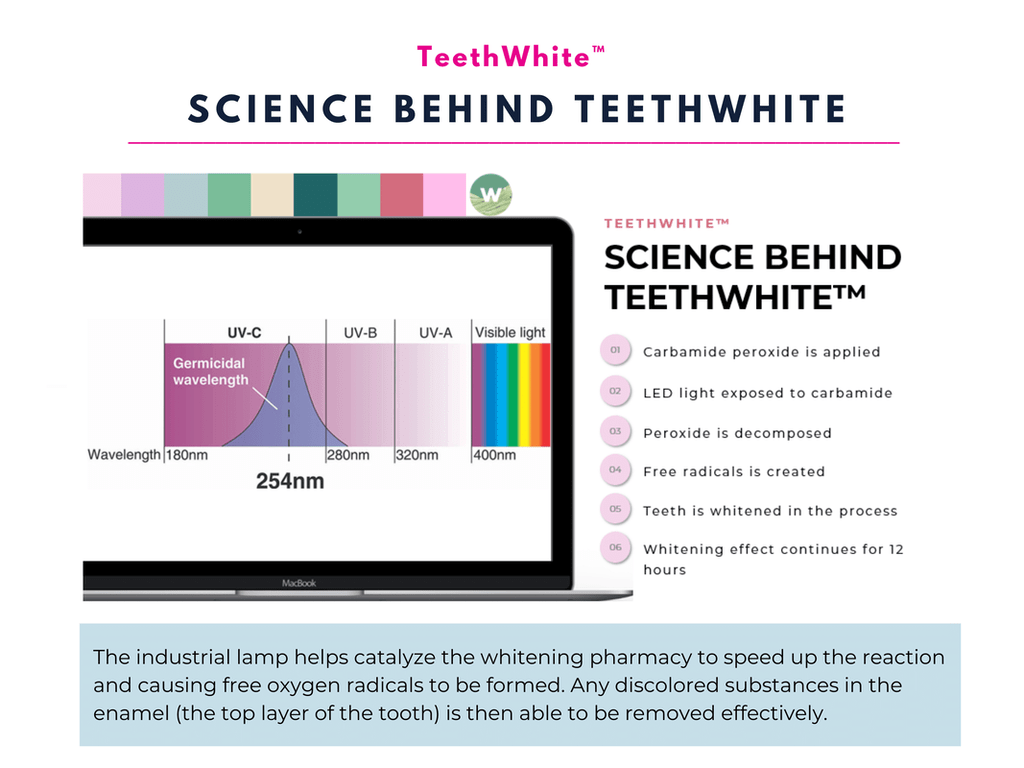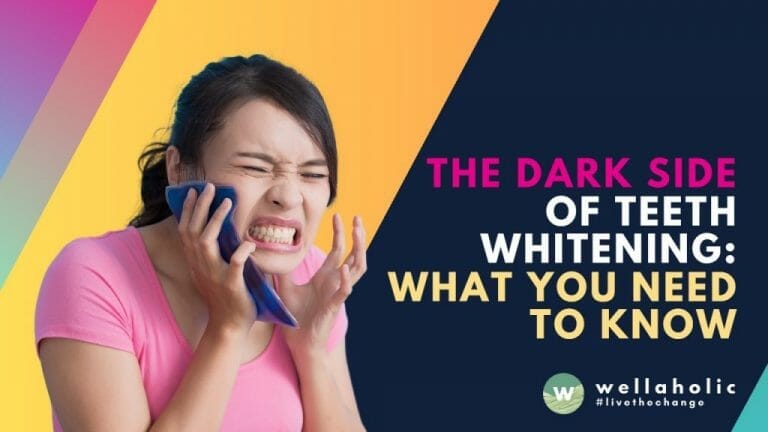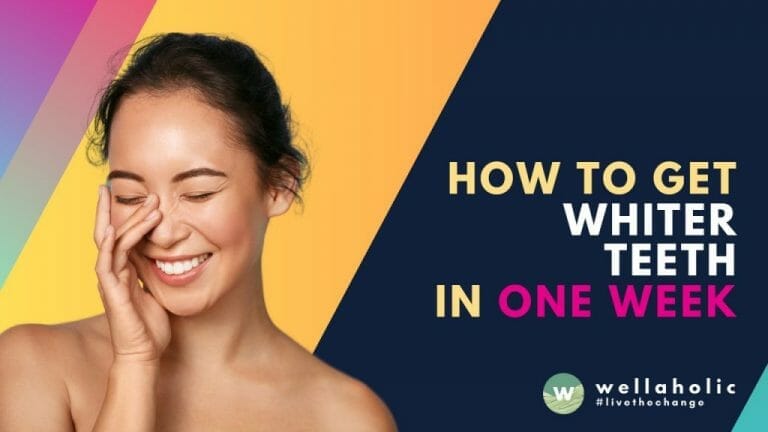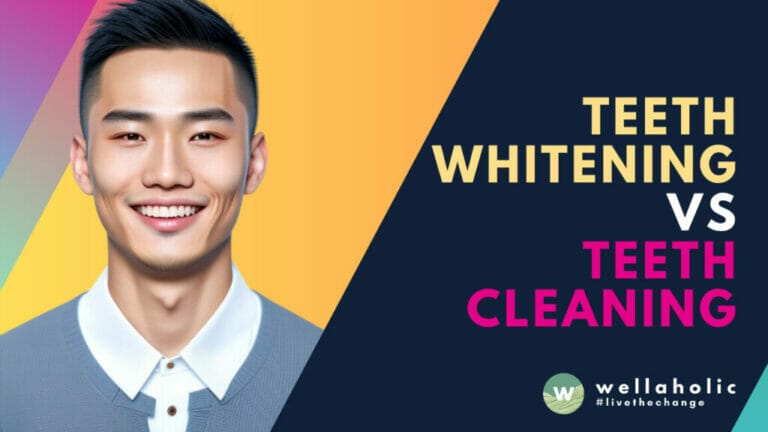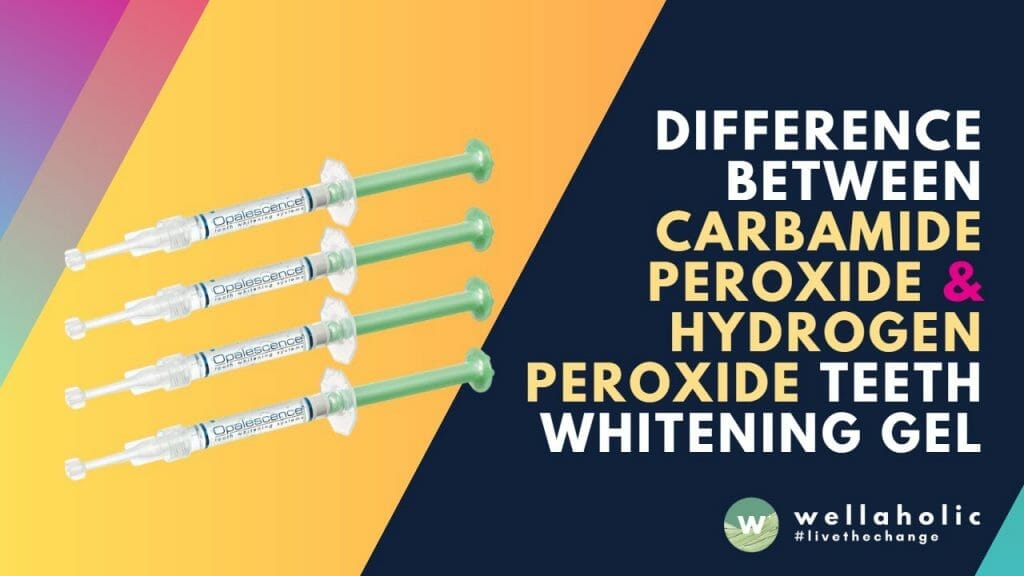
Difference Between Carbamide Peroxide & Hydrogen Peroxide Teeth Whitening Gel
Table of Contents
- 0.1 TL:DR Summary
- 0.2 Introduction: Carbamide Peroxide & Hydrogen Peroxide
- 0.3 Is Carbamide the Same as Hydrogen Peroxide?
- 0.4 Hydrogen Peroxide for Teeth Whitening
- 0.5 Is Hydrogen Peroxide Risky for Teeth Whitening?
- 0.6 Is Carbamide Peroxide Safer for Teeth Whitening?
- 0.7 How Often Can I Use Carbamide Peroxide or Hydrogen Peroxide for Teeth Whitening?
- 0.8 Wellaholic Uses Carbamide Peroxide to Achieve a Brighter Smile
- 0.9 Frequently Asked Questions (FAQ)
- 0.10 Book Now Pay Later
- 0.11 TeethWhite™ Teeth Whitening – Get Up to 12 Shades Whiter
- 1 Understanding Teeth Whitening: Carbamide Peroxide vs Hydrogen Peroxide – A Comprehensive Guide to Dental Bleaching Agents
TL:DR Summary
- Carbamide peroxide vs hydrogen peroxide: Carbamide peroxide breaks down into hydrogen peroxide and urea in the mouth.
- Hydrogen peroxide is more potent: Hydrogen peroxide whitens teeth faster and more effectively than carbamide peroxide.
- Carbamide peroxide is more stable: Carbamide peroxide has a longer shelf life and can be stored at room temperature.
- Carbamide peroxide is gentler: Carbamide peroxide causes less tooth sensitivity and gum irritation than hydrogen peroxide.
- Both are safe and effective: Both carbamide peroxide and hydrogen peroxide are approved by the FDA and ADA for teeth whitening.
- Choose according to your needs: Carbamide peroxide is better for overnight use and sensitive teeth, while hydrogen peroxide is better for quick results and stubborn stains.
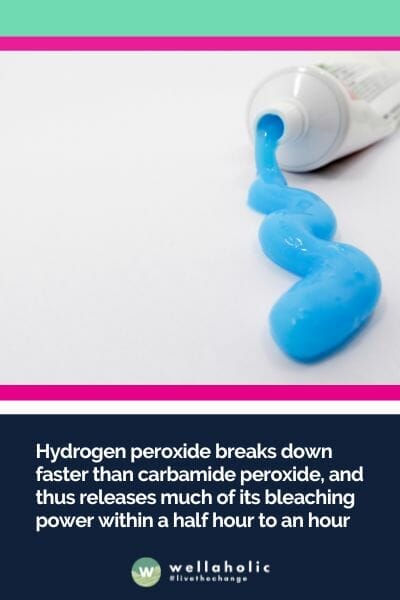
Introduction: Carbamide Peroxide & Hydrogen Peroxide
Welcome to “Difference Between Carbamide Peroxide & Hydrogen Peroxide Teeth Whitening Gel”, an enlightening guide curated by Wellaholic, your trusted aesthetic authority in Singapore. With a legacy of over 7 years, 8 strategically located outlets, a wealth of 2000+ authentic positive customer reviews, and the recognition of over 30 industry awards, we are committed to delivering quality treatments that help you look your best. Our team of teeth whitening experts, backed by our experience of providing over 1000 teeth whitening treatments, provides top-notch teeth whitening treatments. Imagine getting up to 12 shades whiter with just one treatment!
In the world of professional-grade teeth whitening products, two key ingredients stand out: hydrogen peroxide and carbamide peroxide. These compounds serve as the bleaching or stain-removing agents in many treatments. But what sets them apart?
Hydrogen peroxide breaks down faster than carbamide peroxide, releasing much of its bleaching power within a half hour to an hour. Conversely, carbamide peroxide releases about 50 percent of its whitening power at the outset and can remain active for six extra hours.
In this guide, Wellaholic will delve deep into the science of these two compounds, shedding light on their unique properties and how they contribute to the effectiveness of teeth whitening treatments.
Based on a study by Wellaholic Research, professional teeth whitening can last up to 3 years with good oral hygiene habits and regular touch-up treatments.
Is Carbamide the Same as Hydrogen Peroxide?
Both Carbamide Peroxide and Hydrogen Peroxide are similar. Carbamide Peroxide essentially is a more diluted version of Hydrogen Peroxide to reduce risks when used by non-professionals. The great news is that both are considered equally effective in whitening your teeth.
A 16 to 35% carbamide peroxide concentration is generally safe and effective for whitening teeth. A 35% concentration provides significantly more whitening effects compared to a 16% concentration. This is without additional side effects.
Carbamide peroxide release hydrogen peroxide upon contact with teeth, which is a strong oxidizing and bleaching agent. It also release free radicals such as H+ or H3O+. Hydrogen peroxide also acts as an antiseptic, especially in sites with relative anaerobiosis.
Here’s a table showing the key differences between carbamide peroxide and hydrogen peroxide for teeth whitening:
| Features | Carbamide Peroxide | Hydrogen Peroxide |
|---|---|---|
| Chemical Composition | Made up of hydrogen peroxide and urea (carbamide) | Consists of hydrogen peroxide |
| Whitening Ability | Releases half of its whitening power in the first 2 hours of treatment, and then continues to be active for up to 6 hours | Most of its whitening ability released within the first 30 to 60 minutes |
| Speed | Slower release of whitening power | Faster release of whitening power |
| Safety | Considered safe for most people, but may cause tooth sensitivity and gum irritation | May cause tooth sensitivity and gum irritation if used incorrectly or in high concentrations |

Hydrogen Peroxide for Teeth Whitening
How to use hydrogen peroxide to whiten your teeth. Hey, do you want to have a brighter smile? You might want to try hydrogen peroxide. It’s a product that you can use to whiten your teeth. It’s natural and cheap, and it can help you get rid of stains on your teeth. Let me tell you more about it.
What is hydrogen peroxide and how does it work? Hydrogen peroxide is a liquid that has oxygen and hydrogen in it. It can act like a bleach and make things lighter. It can also kill germs and bacteria.
Hydrogen peroxide can whiten your teeth by removing stains that are on the surface of your teeth. These stains can be caused by things like coffee, tea, wine, or smoking. Hydrogen peroxide can make your teeth look whiter and cleaner.
How to use hydrogen peroxide safely and effectively. Hydrogen peroxide can be safe and effective for teeth whitening if you use it correctly. Here are some tips:
- Use a concentration of between three and six percent. This is the strength that you can find at most drugstores or online. Don’t use anything stronger than that, because it can hurt your teeth or gums.
- Use hydrogen peroxide only once in a while. Don’t use it every day or too often, because it can damage your tissues and make your teeth look worse.
- Swish with a small cupful of hydrogen peroxide for up to one minute before brushing your teeth with fluoride toothpaste. This way, you can whiten your teeth and protect them from cavities.
So hydrogen peroxide is a product that you can use to whiten your teeth. It’s natural and cheap, and it can help you get rid of stains on your teeth. But you need to use it correctly and safely to avoid any problems. You should also talk to your dentist before using hydrogen peroxide or any other whitening product to see if they’re right for you.
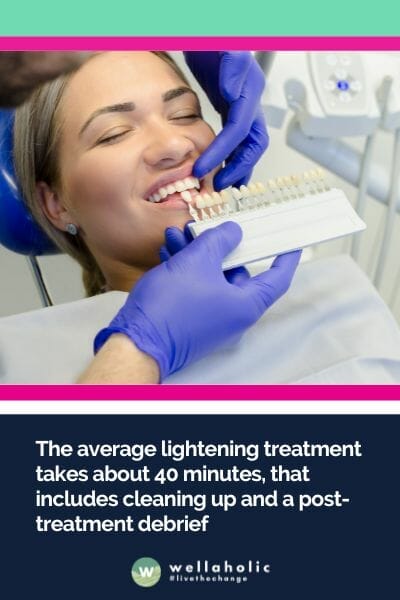
Is Hydrogen Peroxide Risky for Teeth Whitening?
What you need to know about hydrogen peroxide and teeth whitening. Hey, do you know what hydrogen peroxide is? It’s a liquid that has oxygen and hydrogen in it. It can do some amazing things, like kill bacteria and whiten teeth. But it can also do some harmful things, like damage your cells and tissues. Let me tell you more about it.
How hydrogen peroxide works. Hydrogen peroxide works by changing when it touches air. It becomes something else that has more oxygen in it. This is called oxidation.
Oxidation can make hydrogen peroxide very effective to kill bacteria, because it can break their cell wall and destroy them. But oxidation can also make hydrogen peroxide very aggressive, because it can damage most things it touches. This can make hydrogen peroxide a dangerous chemical.
How hydrogen peroxide whitens teeth. Hydrogen peroxide can whiten teeth by using a different type of hydrogen peroxide, called carbamide peroxide. Carbamide peroxide is a product that has hydrogen peroxide and urea in it. Urea is like an acid that can lift up stains from your teeth.
Carbamide peroxide can whiten teeth by breaking down into hydrogen peroxide and urea when it touches your teeth. Then the hydrogen peroxide and urea can bleach your teeth and make them lighter.
How to use hydrogen peroxide safely. Hydrogen peroxide can be safe to use if you use it correctly. Here are some tips:
- Use a low concentration of hydrogen peroxide. The one you can buy at the store or online usually has 3% of hydrogen peroxide and 97% of water. This is safe for your mouth. Don’t use anything stronger than that, because it can hurt your mouth or body.
- Use hydrogen peroxide for a short time. Don’t use it every day or for too long, because it can irritate your gums, tongue, and roof of your mouth. It can also make your teeth more sensitive or prone to decay.
- Don’t swallow hydrogen peroxide. Hydrogen peroxide can damage your esophagus and your internal organs if you swallow it. Spit it out after using it and rinse your mouth with water.
So hydrogen peroxide is a liquid that can do some amazing things, like kill bacteria and whiten teeth. But it can also do some harmful things, like damage your cells and tissues. You need to use it correctly and safely to avoid any problems. You should also talk to your dentist before using hydrogen peroxide or any other whitening product to see if they’re right for you.
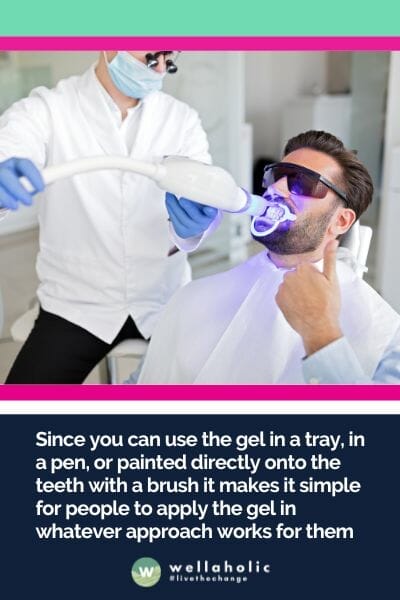
Is Carbamide Peroxide Safer for Teeth Whitening?
How to whiten your teeth with carbamide peroxide in Singapore. Hey, do you want to have a whiter and brighter smile? You might be interested in using carbamide peroxide. It’s a product that can whiten your teeth by removing stains that normal brushing can’t. It’s very popular in Singapore for people who want to improve their smile. But you might be wondering if it’s safe to use. Let me tell you more about it.
What is carbamide peroxide and how does it work? Carbamide peroxide is a product that has hydrogen peroxide and urea in it. Hydrogen peroxide is a chemical that can bleach your teeth. Urea is like an acid that can lift up stains from your teeth.
Carbamide peroxide works by making tiny bubbles of oxygen that go into your teeth and break down stains. These stains can be caused by things like coffee, tea, wine, or smoking. They can make your teeth look yellow or dull.
Is carbamide peroxide safe for teeth whitening? Carbamide peroxide can be safe for teeth whitening if you use it correctly and with professional help. Here are some tips:
- Use a low concentration of carbamide peroxide. The one you can buy at the store or online usually has between 10% and 22% of carbamide peroxide. This is safe for your teeth. Don’t use anything stronger than that, because it can hurt your teeth or gums.
- Use carbamide peroxide for a short time. Don’t use it every day or for too long, because it can make your teeth more sensitive or prone to decay. Follow the instructions on the package or from your dentist on how long to use it.
- See your dentist before using carbamide peroxide. Your dentist can check your teeth and see if they are healthy and suitable for whitening. They can also recommend the best product and treatment for you.
So carbamide peroxide is a product that can whiten your teeth by removing stains that normal brushing can’t. It’s very popular in Singapore for people who want to improve their smile. But you need to use it correctly and safely to avoid any problems. You should also see your dentist before using carbamide peroxide or any other whitening product to see if they’re right for you.
How Often Can I Use Carbamide Peroxide or Hydrogen Peroxide for Teeth Whitening?
Looking to whiten your teeth with carbamide peroxide or hydrogen peroxide? The answer to “How often can I use them?” is simple: follow the instructions on the product packaging or consult with your dentist. But let’s be honest, nobody likes a simple answer. So here’s a witty take on the question: using teeth whitening products too often can have the opposite effect and leave you with sensitive, unhappy teeth. So, use them like you would your ex’s number – sparingly, and only when necessary.
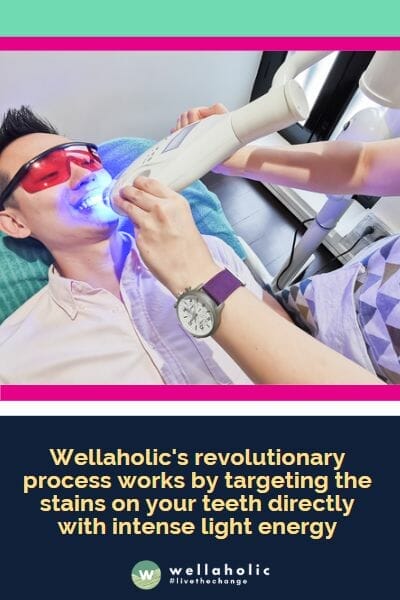
Wellaholic Uses Carbamide Peroxide to Achieve a Brighter Smile
Wellaholic, a popular teeth whitening provider, uses carbamide peroxide as a bleaching agent to achieve a brighter smile for their clients. According to a study conducted by the American Dental Association, patients using carbamide peroxide initially had a more significant change in the color of their teeth compared to those using hydrogen peroxide. While both carbamide and hydrogen peroxide are effective in teeth whitening, the choice of active ingredient may depend on individual needs and preferences. With carbamide peroxide, clients of Wellaholic can rest assured that they are using a reliable and effective bleaching agent to achieve a brighter, more confident smile.
Here’s a useful table showing the benefits and advantages of Wellaholic’s TeethWhite™ teeth whitening treatment:
| Benefits | Details |
|---|---|
| Effective results | TeethWhite™ uses a combination of LED blue light, red light, and a 6000w industrial lamp to activate the teeth whitening gel, which helps to speed up the reaction and make the treatment more effective than teeth whitening kits. |
| Safe and gentle | TeethWhite™ is a safe and gentle method of teeth whitening that does not damage the teeth or gums. The LED lights and whitening gel do not cause any heat or discomfort, and the treatment is non-invasive. |
| Quick and convenient | TeethWhite™ is a fast and convenient treatment that can be completed in just one session, taking only 20 minutes per session. This makes it an ideal choice for people with busy schedules or those who want to see immediate results. |
| Affordable | TeethWhite™ is an affordable teeth whitening treatment compared to other professional teeth whitening methods. It is a great alternative to costly in-office treatments or at-home whitening kits. |
| Personalized treatment | The TeethWhite™ treatment is personalized to each individual’s needs and preferences. The amount of whitening gel and length of the treatment can be adjusted to achieve the desired results. |
Frequently Asked Questions (FAQ)
1. What Are the Key Differences Between Carbamide Peroxide and Hydrogen Peroxide in Teeth Whitening?
Carbamide Peroxide and Hydrogen Peroxide are both used in teeth whitening treatments, but they differ in their composition and how quickly they act. Carbamide Peroxide releases Hydrogen Peroxide more slowly, making it a gentler option for sensitive teeth.
2. Which is More Effective for Teeth Whitening: Carbamide Peroxide or Hydrogen Peroxide?
Both are effective; however, Hydrogen Peroxide acts faster and is often used in shorter treatments, while Carbamide Peroxide is preferred for longer, gradual treatments. The choice depends on individual needs and sensitivity levels.
3. How Does Wellaholic Ensure the Safety of Teeth Whitening Treatments?
Wellaholic employs experienced professionals and uses clinically approved concentrations of whitening agents to ensure the safety and effectiveness of their teeth whitening treatments.
5. What Precautions Should I Take When Using Teeth Whitening Treatments?
It’s important to follow the product instructions carefully and consider a consultation with a dental professional, especially if you have sensitive teeth or existing dental concerns.
6. How Long Do the Results of Teeth Whitening Last?
The duration of teeth whitening results can vary based on dietary habits, oral hygiene, and the type of whitening treatment used. Wellaholic offers guidance on maintaining your results for as long as possible.
7. Are There Any Side Effects to Teeth Whitening?
Some individuals may experience temporary tooth sensitivity or gum irritation. Wellaholic’s treatments are designed to minimize these effects while providing effective whitening results.

Serene Chiam, Aesthetic Director
Serene Chiam is the Aesthetic Director at Wellaholic, a well-known aesthetic chain in Singapore. She has more than ten years of experience in the aesthetics industry. With a Bachelor of Health Science (Aesthetics) and CIDESCO certifications, she expertly combines scientific knowledge with practical skills. Serene is known for her personalized approach to beauty, ensuring each Wellaholic client’s journey is unique and transformative. Her significant contributions have been pivotal in establishing Wellaholic’s reputation for excellence in aesthetic wellness.
Contact Serene at support@wellaholic.com
GET IN TOUCH
Book Now Pay Later
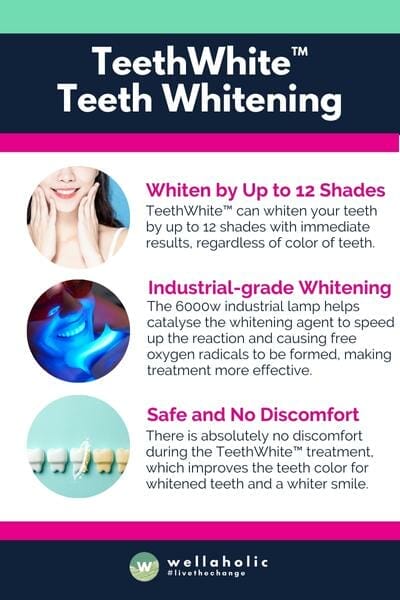
TeethWhite™ Teeth Whitening – Get Up to 12 Shades Whiter
- ⭐ Immediate Results. TeethWhite™ brightens your smile up to 12 shades in a single session, offering an instant boost to your confidence.
- ⭐ Industrial-Grade Whitening. TeethWhite™ teeth whitening employs industrial-grade lamps for optimal whitening results.
- ⭐ Effective Ingredients: Our teeth whitening gel features Carbamide Peroxide, a proven and potent whitening agent.
- ⭐ Advanced technology: TeethWhite™ uses strong LED light technology to activate the whitening gel and ensure thorough and consistent results.
- ⭐ Award-Winning. Wellaholic’s treatments have been recognized by top beauty publications such as Daily Vanity, Beauty Insider, and Tropika Club Magazine.
- ⭐ Over 2000 Verified Customer Reviews. Wellaholic has over 30 industry awards and over 2000 positive reviews from customers, and >50% are repeat customers.
